
Olá pessoal, hoje gostaria de compartilhar com vocês uma batalha que tive. Às vezes, arriscar e conseguir uma vitória é muito satisfatório. Este é o motivo deste post. Às vezes, eu gosto de arriscar, pois a sensação é muito maior. Mesmo sabendo que teria um time melhor, arriscar e ver que a estratégia deu certo é muito gratificante.
Arriscar
Acho que todo mundo, às vezes, monta um time meio arriscado. Acho que sempre ficar na mesma coisa não é legal e variar é algo muito importante, mesmo que na maioria das vezes não dê certo. Entender como o inimigo joga e tentar montar um time tentando prever o que o inimigo fará, temos algumas opções para tentar nos sobressair sobre o inimigo. E às vezes, temos opções muito específicas que podem nos levar à derrota total.
Acho muito válido tentar ganhar por completo do inimigo, conseguir sair sem perder nem uma carta, e é uma das melhores sensações que conseguimos ter jogando Splinterlands.
Quem não arrisca não petisca.
Como a própria frase diz, às vezes sair do óbvio e ir por outro caminho pode ser a solução. Querendo ou não, sempre teremos uma tendência de jogo, seja de repetir elementos, cartas, modos de jogo, e muitas vezes seremos penalizados por isso. Então, tentar sair um pouco da zona de conforto pode surpreender muito o inimigo.
A Batalha
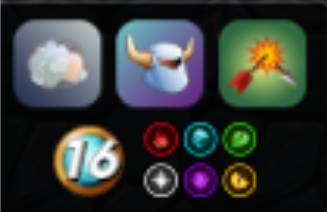
Minha ideia nesta batalha foi arriscar tudo em cartas de suporte. Os suportes cada vez estou achando mais úteis, pois geralmente não têm nem um ataque, mas conseguem agregar muito para o time, seja com habilidades ou conseguindo segurar muito dano. Estou tentando achar o equilíbrio em usar essas cartas, pois nem sempre elas serão eficazes. Não são simples de encaixar na batalha, mas são muito fortes.
Como disse antes, nesta batalha meu foco foi em cartas suporte. Por isso, arrisquei tudo colocando apenas uma carta com dano. As chances de dar errado eram enormes.
O que permitiu montar um time tão diferente foi as regras da partida, especialmente a exclusão da habilidade sneak, que poderia causar muitos problemas, e a regra de não ter cartas arqueiras na batalha. A regra de escudo era vantagem para mim, pois iria usufruir dela na batalha. Levando todas as regras e a mana baixa em consideração, foi possível montar um time bem diferente.
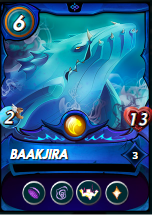
Minha primeira escolha foi Baakjira, uma carta que tem vários pontos positivos, principalmente por ter várias habilidades que a tornam muito forte e alinhada com seu custo de mana médio. Ela tem muita força na batalha.
Baakjira é um terror contra magos e cartas com pouco ataque, pois consegue fazer muito com sua habilidade de cura. Além disso, possui resistência a ataques mágicos e outras duas habilidades excelentes, adicionando +1 de vida a todos os aliados e nerfando -1 a velocidade inimiga. Para ter todas essas habilidades, precisa estar no nível 3, o que não é barato, mas às vezes é possível alugá-la barato.
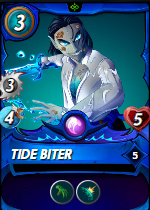
Minha segunda escolha para a batalha, a única carta do time responsável pelo dano, foi escolhida por suas duas habilidades. Sendo uma carta corpo a corpo, normalmente não poderia causar dano aos inimigos caso não estivesse na primeira posição. Mas, como possui a habilidade de alcançar, permite que essa carta, mesmo na segunda posição, ataque o inimigo. Além disso, possui uma segunda habilidade muito importante, que evita algumas habilidades muito fortes, como espinhos e explosão. Essas habilidades podem ser um grande obstáculo na batalha.
Minha ideia para essa carta foi simples. Por ser uma batalha de mana baixa, não seria possível para o inimigo colocar muitas cartas com dano. Então, na minha cabeça, uma única carta com dano seria capaz de lidar com o adversário. Para isso funcionar, era necessário que todas as cartas suporte fossem capazes de exercer suas funções corretamente.
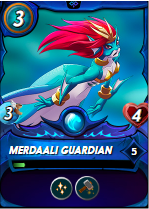
Aqui está minha última aposta para essa batalha: mais uma carta de suporte. Para mim, essa carta é muito forte, pois possui duas habilidades fortes, seja de cura ou de reconstruir armaduras quebradas, o que deixa a carta mais forte, e principalmente, seu custo de mana baixo, que facilita muito encaixar em batalhas. Temos um foco claramente em batalhas de custo médio para baixo, mas em batalhas que sobrar uma mana, às vezes compensa escolher esta carta em vez de outra que dá dano.
Minha ideia com esta carta era simplesmente cobrir a cura da carta da linha de frente e segurar os danos, tanto com o alto poder de cura das duas cartas, quanto com os escudos, pois com a regeneração dos escudos, seguraria muito dano também.
Vamos para a luta.
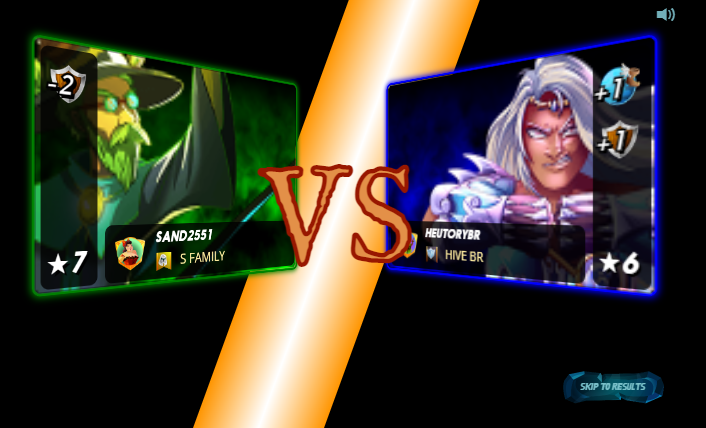
Aqui estão os competidores: eu e meu inimigo. O inimigo veio com o invocador de terra, que não é muito comum de se ver em batalhas. Esse invocador tem a habilidade de diminuir até 2 o número de escudos do inimigo em certas ocasiões, tornando-se muito forte. No meu caso, vim com o deck de água, com o invocador que concede +1 de escudo e +1 de velocidade.
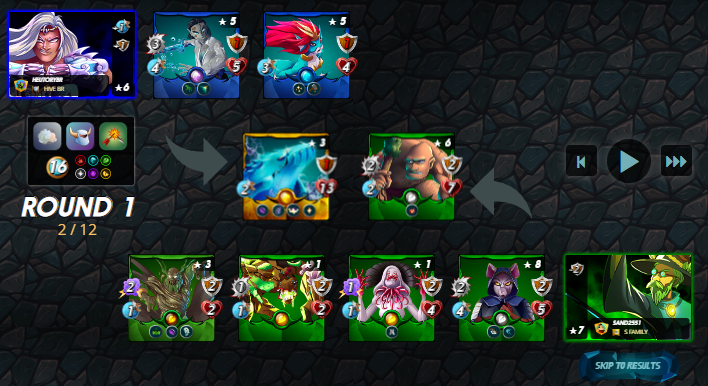
Aqui podemos ver ambos os times, sendo que será um 3 vs 5. Quando vi o time do inimigo, fiquei assustado, pois tinha cartas que poderiam causar muitos problemas, como a carta Queen Mycelia e Venari Scout, mas para minha sorte, o inimigo veio com duas cartas mágicas, que era justamente o que eu estava contando para esta partida, que era lutar contra magos.
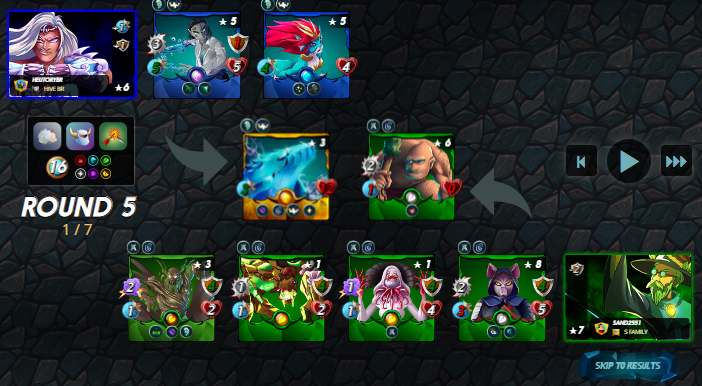
Como podemos ver, só tivemos uma carta eliminada na quinta rodada. Ao montar meu time, consegui que fosse muito eficiente contra o inimigo. Posso dizer que foi sorte também, mas enfim, com dois suportes e com as regras da batalha, o inimigo não está sendo capaz de causar dano no meu time, sendo assim, minha carta com dano está a cada rodada causando dano e levando os poucos inimigos.
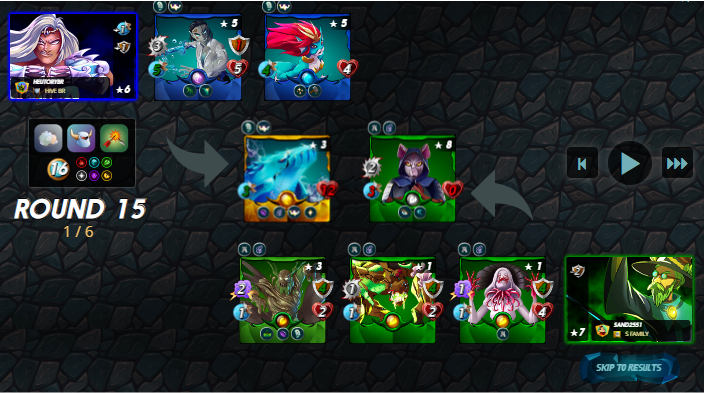
Depois de 10 rodadas e muitos desvios da carta Venari Scout, foi possível abater a carta. O lado negativo de ter apenas uma carta com dano é que ela coloca toda a responsabilidade de dano em si, o que pode ser complicado e às vezes pode custar a vitória. Por sorte, os ataques inimigos não causaram dano.
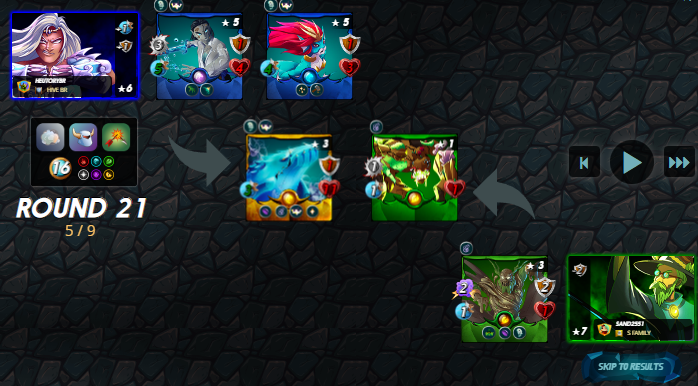
Chegamos ao ponto do jogo em que o dano decide a partida. Por sorte minha, minhas cartas estavam com mais vida e tinham a habilidade de cura, senão isso poderia complicar para o meu lado. A lição nesta partida é que, mesmo neutralizando por completo o inimigo, não significa que a vitória se torna fácil, especialmente quando temos uma única carta responsável pelo dano.


Hello everyone, today I would like to share with you a battle I had. Sometimes, taking a risk and achieving a victory is very satisfying. This is the reason for this post. Sometimes, I like to take risks because the feeling is much greater. Even knowing that I would have a better team, taking a risk and seeing that the strategy worked is very rewarding.
Risking
I think everyone, sometimes, builds a bit of a risky team. I think always staying the same is not fun and changing is very important, even if most of the time it doesn't work. Understanding how the enemy plays and trying to build a team trying to predict what the enemy will do, we have some options to try to stand out over the enemy. And sometimes, we have very specific options that can lead us to total defeat.
I think it's very valid to try to win the enemy completely, get out without losing a card, and it's one of the best feelings we can have playing Splinterlands.
Nothing ventured, nothing gained.
As the saying goes, sometimes stepping away from the obvious and going down another path can be the solution. Whether we like it or not, we will always have a game tendency, be it repeating elements, cards, gameplay modes, and often we will be penalized for this. So, trying to step out of the comfort zone can surprise the enemy a lot.
The Battle

My idea in this battle was to risk everything on support cards. I'm finding support cards more and more useful, as they usually don't have an attack, but they can add a lot to the team, whether with abilities or holding a lot of damage. I'm trying to find the balance in using these cards, as they won't always be effective. They are not easy to fit into battle, but they are very strong.
As I said before, in this battle my focus was on support cards. So I took a chance by putting only one card with damage. The chances of going wrong were huge.
What allowed me to assemble such a different team was the match rules, especially the exclusion of the sneak ability, which could cause many problems, and the rule of no archery cards in battle. The shield rule was an advantage for me, as I would use it in the battle. Taking all the rules and the low mana into consideration, it was possible to assemble a very different team.

My first choice was Baakjira, a card that has many positive points, mainly because it has several abilities that make it very strong and aligned with its average mana cost. It has a lot of strength in battle.
Baakjira is a terror against mages and cards with low attack, as it is able to do a lot with its healing ability. In addition, it has resistance to magic attacks and two other excellent abilities, adding +1 life to all allies and nerfing -1 to enemy speed. To have all these abilities, it must be at level 3, which is not cheap, but sometimes it can be rented cheaply.

My second choice for the battle, the only card on the team responsible for damage, was chosen for its two abilities. Being a melee card, it normally couldn't cause damage to enemies if it wasn't in the first position. But, with its reach ability, it allows this card, even in the second position, to attack the enemy. In addition, it has a second very important ability, which avoids some very strong abilities, such as thorns and explosion. These abilities can be a big obstacle in battle.
My idea for this card was simple. Because it was a low mana battle, it wouldn't be possible for the enemy to put many damage-dealing cards. So, in my head, a single damage card would be able to deal with the adversary. For this to work, it was necessary that all support cards be able to perform their functions correctly.

Here is my last bet for this battle: another support card. To me, this card is very strong, as it has two strong abilities, either healing or rebuilding broken armor, which makes the card stronger, and mainly its low mana cost, which makes it much easier to fit into battles. We have a clear focus on medium to low cost battles, but in battles that spare a mana, sometimes it pays to choose this card instead of another that deals damage.
My idea with this card was simply to cover the healing of the front line card and hold back the damage, both with the high healing power of the two cards and with the shields, as with the regeneration of the shields, it would also hold back a lot of damage.
Let's go to the fight.

Here are the competitors: myself and my enemy. The enemy came with the Earth Caller, which is not very common to see in battles. This caller has the ability to reduce the enemy's number of shields by up to 2 in certain situations, making it very strong. In my case, I came with the water deck, with the caller that grants +1 shield and +1 speed.

Here we can see both teams, being a 3 vs 5. When I saw the enemy's team, I was frightened because it had cards that could cause many problems, such as the Queen Mycelia and Venari Scout cards, but to my luck, the enemy came with two magic cards, which was just what I was counting on for this match, which was to fight against wizards.

As we can see, we only had one card eliminated in the fifth round. By putting together my team, I managed to make it very efficient against the enemy. I can say that it was also luck, but anyway, with two supports and with the battle rules, the enemy is not able to cause damage to my team, so my damage card is causing damage and taking down the few enemies every round.

After 10 rounds and many deviations from the Venari Scout card, it was possible to take down the card. The downside of having only one damage card is that it puts all the responsibility of damage on itself, which can be complicated and sometimes cost the victory. Fortunately, the enemy's attacks did not cause damage.

We have reached the point in the game where damage decides the match. Fortunately for me, my cards were with more life and had the healing ability, otherwise it could complicate things for my side. The lesson in this game is that, even neutralizing the enemy completely, it does not mean that victory becomes easy, especially when we have a single card responsible for damage.







